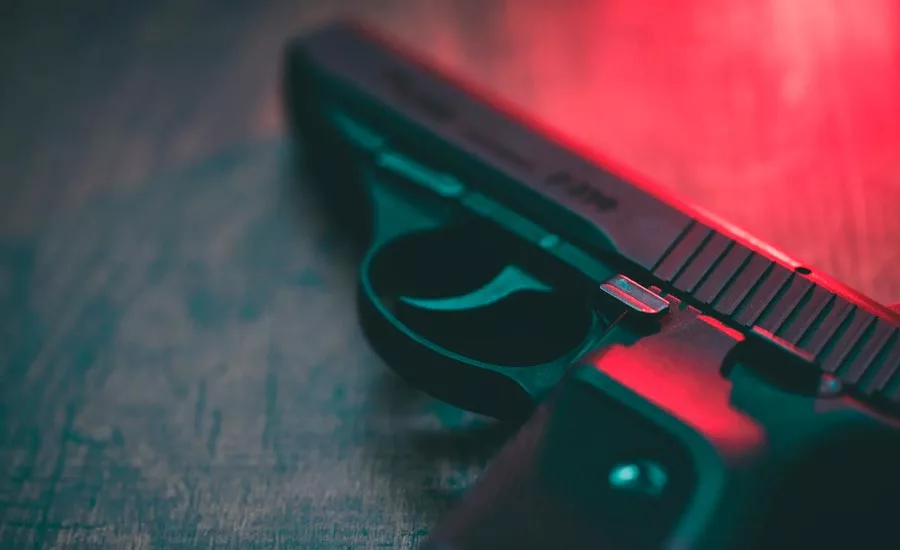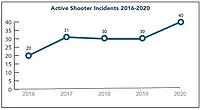FBI designates 40 shootings in 2020 as active shooter incidents

The Federal Bureau of Investigation (FBI) has designated 40 shootings in 2020 as active shooter incidents. The FBI defines an active shooter as one or more individuals actively engaged in killing or attempting to kill people in a populated area. Implicit in this definition is the shooter’s use of a firearm. The active aspect of the definition inherently implies the ongoing nature of an incident, and thus the potential for the response to affect the outcome.
Although 2020 witnessed the highest rate of active shooter incidents for the period 2000 to 2020, casualties were significantly lower. There could be several reasons for the sharp decline in casualty counts.
One potential explanation is that many people avoided public spaces during the COVID-19 pandemic, which presented fewer active shooter casualty opportunities in traditional target-rich environments (i.e., restaurants, movie theatres, sports stadiums, workplaces, schools, etc.). 2020 did see several national and prominent public protests drawing large crowds of people, essentially presenting a target-rich environment. However, there were only two active shooter incidents in these environments in 2020; the casualty totals for these two incidents accounted for one killed and six wounded.

Since 2016, active shooter incident data reveals an upward trend. The number of active shooter incidents identified in 2020 represents a 33% increase from 2019 and a 100% increase from 2016. A breakdown of number of incidents by year follows:
- 2016: 20
- 2017: 31
- 2018: 30
- 2019: 30
- 2020: 40
CREDIT: FBI

April had the fewest number of incidents (zero) and June had the highest number of incidents (eight). In addition, no active shooter incidents occurred on Tuesdays; Saturdays saw the most incidents (15).
CREDIT: FBI

Of the 40 active shooter incidents in 2020, 58% (23 incidents) occurred during p.m. hours (between 12:00 p.m. and 11:59 p.m.), and 42% (17 incidents) occurred during a.m. hours (between 12:00 a.m. and 11:59 a.m.). Data shows that an active shooter incident is more likely to occur (67.5%) between 6:00 p.m. to 6:00 a.m. (27 incidents occurred during this timeframe). A breakdown of number of incidents by time period follows:
- 12:00 a.m. to 6:00 a.m.: 9
- 6:01 a.m. to 11:59 a.m.: 8
- 12:00 p.m. to 6:00 p.m.: 5
- 6:01 p.m. to 11:59 p.m.: 18
CREDIT: FBI

The 40 active shooter incidents in 2020 occurred in 19 states:
- Six incidents occurred in California.
- Five incidents occurred in Illinois.
- Three incidents each occurred in Florida, Texas, and Missouri.
- Two incidents each occurred in Arizona, Idaho, North Carolina, New York, Oklahoma, South Carolina and Wisconsin.
- One incident each occurred in Alaska, Indiana, Kansas, Kentucky, Nebraska, Nevada and Tennessee.
- Five of the 40 incidents met the criteria cited in the federal definition of mass killings (three or more killings in a single incident.)
CREDIT: FBI

The 40 active shooter incidents reviewed in this report resulted in 164 total casualties (38 killed and 126 wounded, excluding the shooters). The incident with the highest number of total casualties (one killed and 16 wounded) occurred at 9ine Ultra Lounge in Kansas City, Mo. The second highest number of casualties (nine wounded) occurred at an unspecified residential address in Manteca, Calif.
A breakdown of the incidents/locations with the five highest total casualty counts follows:
- 9ine Ultra Lounge, Kansas City, Mo.: 1 killed, 16 wounded
- Unspecified residential address, Manteca, Calif.: 9 wounded
- Rebar Bar and Lounge, San Antonio, Texas: 8 wounded
- Infinity Lounge, Kingstree, S.C.: 8 wounded
- Mayfair Mall, Wauwatosa, Wis.: 8 wounded
CREDIT: FBI

While the number of active shooter incidents doubled since 2016 (see Figure 1), casualty counts decreased to the lowest number in five years. Although there are several possible reasons for the decline in casualty counts, one potential explanation is that many people avoided public spaces during the COVID-19 pandemic lockdowns, which presented fewer active shooter casualty opportunities in target-rich environments (i.e., restaurants, movie theatres, stadiums, workplaces, schools, etc.).
The average number of casualties for the 2016-2019 period is approximately 358 per year, even with the inclusion of the atypical Route 91 Harvest Festival shooting in Las Vegas, Nev. A breakdown of the number of total casualties by year follows:
- 2016: 214
- 2017: 734
- 2018: 225
- 2019: 258
- 2020: 164
CREDIT: FBI

Twenty-four of the 40 active shooter incidents occurred in areas of commerce, resulting in 31 killed and 81 wounded.
- Nineteen incidents occurred in business environments open to the public, resulting in 21 killed, including one store owner, three employees and one law enforcement officer. Sixty-four were wounded, including four employees and one law enforcement officer. Two of the shooters were known to be employees of the businesses (one was the owner). Of the 19 shooters, one of the shooters wore body armor. Eleven shooters were apprehended by law enforcement (four at the scene and seven at other locations), one shooter was killed by law enforcement at the scene, one shooter was killed by an armed citizen at the scene, and one shooter was killed by armed citizen/security personnel at the scene. One shooter committed suicide before police arrived at the scene, and three shooters committed suicide after police arrived at the scene. There were two incidents in which there were no casualties.
- Four incidents occurred in business environments closed to pedestrian traffic, resulting in 10 killed from three separate incidents involving 10 employees. Nine were wounded, including four employees (two from injuries incidental to the shooting). Two shooters were employees, and one shooter was a previous employee. One shooter was apprehended at the scene, one shooter committed suicide at the scene, one shooter committed suicide when confronted by law enforcement at another location, and one shooter remains at large.
- One incident occurred in a mall, resulting in eight people wounded. The shooter was apprehended by law enforcement at another location.
- Ten of the 40 incidents occurred in open space locations, resulting in three killed and 28 wounded. None of the shooters wore body armor. Four shooters were apprehended by law enforcement (two at the scene and two at other locations), one shooter was killed by an off-duty law enforcement officer at the scene, and two shooters remain at large. In one incident, four law enforcement officers were wounded.
- Three of the 40 incidents occurred on government property, resulting in three wounded (two law enforcement officers and one naval air station security force guard). None of the shooters wore body armor. Two shooters were apprehended by law enforcement at the scene; one shooter was killed by law enforcement at the scene.
- Two incidents occurred on military property, resulting in one wounded (naval air station security force guard).
- Three of the 40 incidents occurred at residence(s), resulting in four killed and 14 wounded, including one law enforcement officer. None of the shooters wore body armor. One shooter was apprehended by law enforcement at another location; one shooter committed suicide at the scene after law enforcement arrived.
CREDIT: FBI

Forty-two shooters carried out 40 active shooter incidents. Thirty-five shooters were male, three were female, and four were unspecified. Thirty-nine shooters acted alone, and three shooters acted together. The youngest shooter was 15 years old; the oldest shooter was 87 years old. A breakdown of the shooters’ ages follows:
- Teens: 1
- 20s: 9
- 30s: 16
- 40s: 4
- 50s: 3
- 60s: 2
- 70s: 1
- 80s: 1
- Unknown: 5
CREDIT: FBI
Looking for a reprint of this article?
From high-res PDFs to custom plaques, order your copy today!




